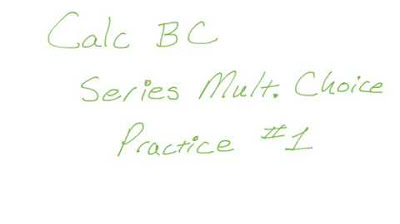Infinite Series Multiple Choice Practice for Calc BC (Part 5)
TLDRThis video script is a comprehensive walkthrough of multiple-choice calculus problems aimed at preparing students for the BC Calculus exam. The presenter tackles a variety of series convergence questions, employing tests such as the Ratio Test, the Alternating Series Test, and the nth Term Test for divergence. The script also delves into geometric series, integral tests, and the application of L'Hôpital's rule. The presenter's candid approach to problem-solving, including their strategy of choosing answers based on patterns and denominator differences, offers insight into the thought process behind calculus problem analysis. The script is a valuable resource for those looking to enhance their calculus skills and understanding of series convergence.
Takeaways
- 📚 The video is a part of a series focusing on multiple-choice questions to prepare for the BC Calculus exam.
- 🔍 Conditional convergence is discussed, which means a series converges when alternating but not when considering the absolute values of terms.
- 📉 The ratio test is used to determine absolute convergence, and it involves looking at the limit of the ratio of consecutive terms.
- 🔢 The p-series test is mentioned, which involves checking if the series terms' absolute value raised to the power of 'p' is less than 1.
- 🔄 Alternating series test is used to determine if a series with alternating signs converges, provided the terms decrease in magnitude and approach zero.
- 🌀 Geometric series are discussed, and their convergence is determined by the value of the common ratio.
- 📊 The nth term test, often requiring L'Hôpital's rule, is used to determine if a series diverges.
- 📋 The integral test is used for series that can be represented by an integrable function, and it involves comparing the series to an integral from 2 to infinity.
- 📌 The limit of the terms of a series is important, especially when considering whether they approach zero, which can indicate convergence.
- 📐 The concept of using inequalities to compare series and integrals is explored, with the series often lying between two calculated integrals.
- ✅ The video provides a strategy for tackling calculus series questions, emphasizing the importance of understanding different tests for convergence and divergence.
Q & A
What does 'conditionally convergent' mean in the context of series?
-A series is conditionally convergent if it converges when the terms are alternating but does not converge when considering the absolute value of the terms.
What test is suggested to determine if the first series in the video is convergent?
-The ratio test is suggested for determining the convergence of the first series, as it is effective in handling absolute values.
What is the condition for a geometric series to converge?
-A geometric series converges if the absolute value of its common ratio is less than one.
How does the speaker determine the convergence of the series involving e^(kx)?
-The speaker rewrites e^(kx) as e^(x^k) to make it overtly geometric, then uses the formula for the sum of a geometric series, considering the absolute value of e^x must be less than 1 for convergence.
What is the strategy the speaker uses for the problem involving series with terms t^2/(b^2)^k?
-The speaker decides to attempt option A first and see if it is the answer, noting the similarity in the form of most options and focusing on the denominators to deduce the correct answer without doing excessive work.
What is the condition for the infinite series involving x/(y*(x/y)^2)^n to converge?
-The series converges if the absolute value of (x/y^2) is less than one, which implies that x must be less than y^2.
Why does the speaker believe the integral test is applicable to the series involving 1/(n*ln(n))?
-The speaker believes the integral test is applicable because the series terms resemble an integrable function, and there are no other obvious tests that would work better.
What is a characteristic of the function that makes it suitable for the integral test?
-The function must be positive, continuous, and monotonically decreasing over the interval being considered for the integral test to be applicable.
How does the speaker use the alternating series test to show that a series does not converge absolutely?
-The speaker notes that the terms of the series alternate in sign, decrease in magnitude, and the limit of the terms as n approaches infinity is zero, which is a condition for convergence by the alternating series test.
What is the conclusion about the series involving 1/(n^2) after applying the integral test?
-The conclusion is that the series is convergent because the integral of the function from 1 to infinity of 1/x^2 is finite.
How does the speaker approach the problem of finding which inequality is true for the series 1/n^2?
-The speaker uses both right and left Riemann sums and compares them to the integral of the function from 1 to infinity of 1/x^2 to deduce that the series is bounded by the sum of the rectangles and the integral.
Why does the speaker believe that the series sum is between the two integrals calculated?
-The speaker uses the properties of decreasing functions and Riemann sums to show that the sum of the rectangles (representing the series partial sums) is less than the integral from 1 to infinity and greater than the integral from 2 to infinity, thus placing the series sum between these two values.
Outlines
📚 Calculus Series Convergence Tests Overview
The video begins with an introduction to a series of multiple-choice questions aimed at preparing for the BC Calculus exam. The focus is on understanding conditional convergence, absolute convergence, and the application of various tests like the ratio test and alternating series test to determine if a series converges or diverges. The presenter provides step-by-step analysis for series involving factorials, geometric progressions, and exponential functions, emphasizing the importance of recognizing the nature of the series to apply the correct test.
🔢 Series Convergence Analysis with Geometric and Exponential Terms
The presenter continues the discussion on series convergence by examining geometric series with exponential terms. They demonstrate the process of rewriting series to make them more recognizable as geometric, and then applying the appropriate tests to determine convergence. The video also covers the use of the integral test for series involving natural logarithms and provides a strategy for tackling multiple-choice questions efficiently by eliminating incorrect options based on the nature of the series and the tests involved.
🧮 Applying the Integral Test to Series Convergence
The video segment delves into the integral test, a method for assessing the convergence of series by comparing it to the integral of its function. The presenter uses the integral test to verify the convergence of a series involving the natural logarithm. They also discuss the conditions under which the integral test is applicable, such as the function being positive, continuous, and decreasing over the interval of integration. The presenter emphasizes the importance of notation and the steps involved in performing the test.
🏞️ Visualizing Series Convergence with Riemann Sums
The final paragraph of the script explores inequalities involving series and their integrals using visual methods such as Riemann sums. The presenter illustrates how to use both right and left Riemann sums to establish inequalities that can help determine the convergence of a series. They also discuss the strategy of adding the first term of the series to the sum of the rectangles to align with the series terms. The presenter concludes by suggesting that while this method might not be commonly tested, it provides a satisfying way to visualize and understand series convergence.
Mindmap
Keywords
💡Conditionally convergent
💡Ratio test
💡Geometric series
💡nth term test for divergence
💡Alternating series test
💡Factorial
💡L'Hôpital's rule
💡Integral test
💡p-series
💡Exponential function
💡Riemann sum
Highlights
The video is part of a series preparing for the BC Calculus exam, focusing on multiple-choice questions.
Conditional convergence is explained, where a series converges when alternating but not when considering absolute values.
The ratio test is used to determine absolute convergence of a series.
The concept of p-series and its convergence criteria is discussed, with p being less than 1.
The alternating series test is used to show convergence of a series with terms that alternate and decrease in magnitude.
The video covers the convergence of factorial-based series and geometric series using the ratio test and direct observation.
L'Hôpital's rule is mentioned for determining the convergence of a series using the nth term test for divergence.
A geometric series with an exponential function is analyzed, with the sum provided under a certain condition.
The integral test is introduced for assessing the convergence of series, particularly those that can be represented by an integrable function.
The video explains how to use the integral test on a classic problem involving the natural logarithm, leading to a divergence conclusion.
The concept of a series having a limit of zero is discussed in the context of the integral test.
A comparison of geometric series is made by analyzing the common ratio and its absolute value.
The video demonstrates how to use the integral test to verify the convergence of a p-series, despite it being a straightforward case.
Inequalities involving series and integrals are explored, with a focus on graphical methods and Riemann sums.
A strategy for time management on exams is shared, emphasizing the importance of quick identification of answer options.
The video concludes with a reminder that while certain topics may seem less likely on exams, it's important to be prepared for a variety of questions.
Transcripts
Browse More Related Video

AP Calc BC Series Review Multiple Choice Practice

Infinite Series Multiple Choice Practice for Calc BC (Part 6)

Infinite Series Multiple Choice Practice for Calc BC (Part 1)

Infinite Series Multiple Choice Practice for Calc BC (Part 4)

AP Calculus BC 2008 Multiple Choice (no calculator) - questions 1 - 28

Monday Night Calculus: Strategy for testing series
5.0 / 5 (0 votes)
Thanks for rating: